What is compressive strength?
The ability of a material or structure to withstand stresses that tend to cause it to shrink is known as compressive strength, also known as strength under compression. In other words, compressive strength resists compression, whereas tensile strength resists tension. When analyzing a material’s strength, it is possible to look at its tensile strength, compressive strength, and shear strength independently.
Compressive strength is the ability of a material or structural component to withstand loads that, when applied, force them to contract in size. A force is applied to a test sample at both its top and bottom until it breaks or deforms.
As a result of the regular use of this technique to evaluate materials like rock and concrete, fracture occurs when these materials are evaluated for compressive strength.
Steel, among other materials, can be tested for compressive strength, and ductile materials typically deform. A ductile substance will initially adjust to the applied load by altering the way its internal structure is organized, a process known as plastic flow.
When the distortion is focused in one area, the material fractures, and the plastic flow stops. Typically, the indicator used to gauge and contrast ductile metals is tensile strength. This is so that the forces necessary to rip a material apart can be measured using tensile stress, which is better suited to the plastic flow phenomenon.
Compressive strength evaluations: the equation is used to calculate compressive strength.
Compressive Strength Formula
F = P/A is the formula to determine compressive strength, where:
- F denotes compressive strength (MPa).
- P = Maximum material load (or load up to failure) (N)
- A is a cross-section of the material’s load-resisting area (mm2)
The Introduction of Compressive Strength
When the material reaches its compressive strength, it will either fail brittlely or ductilely (with infinite theoretical yield) (rupture as the result of crack propagation, or slide along a weak plane).
Compressive strength is tested on materials, components, and structures. The ultimate compressive strength of a material is, by definition, the amount of uniaxial compressive stress that it can withstand before failing.
Compressive strength measurements are influenced by the specific test protocols and measuring setup. Compression strengths are often specified following a certain technical standard.
Concrete and ceramics frequently have significantly higher compressive strengths compared to materials with high tensile strengths. Composite materials like glass fiber epoxy matrix composite frequently have tensile strengths that are higher than compressive values.
Concrete is typically strengthened with compounds that can withstand stress. Concrete quality assurance and specification criteria typically use compressive strength. Engineers are aware of the objective tensile (flexural) requirements, and they represent these requirements in terms of compressive strength.
Compressive strength requirements for residential concrete may range from 2,500 psi to 4,000 psi and higher for commercial structures. Higher strengths, up to and above 10,000 psi, are needed for specific applications.
For both brittle and ductile materials, the compressive strength is often substantially greater than the tensile strength. The exception to this rule is fiber-reinforced composites like fiberglass, which are tough in tension but easily crushed.
However, if the concrete is going to be subjected to tensile stresses, steel rods must be used as reinforcement since concrete, a particle-reinforced composite, is much stronger in compression than in tension.
Which Materials Have The Highest Or Lowest Compressive Strengths?
The compressive strength of rock and other brittle materials is frequently 140 MPa or more. Compressive strengths of 60 MPa or less are typical for sandstone and other softer types.
Compressive strength of roughly 250 MPa is typical for ductile materials like mild steel in structural applications.
Which Applications Require High or Low Compressive Strength?
When it comes to concrete, ultra-high-strength concrete is used to construct structures like highway bridges that must be able to withstand enormous loads and strains, whereas normal household pavement uses concrete with a compressive strength of 30 MPa.
Deviation of Engineering Stress From True Stress
In the practice of engineering design, experts mostly use engineering stress. In reality, stress is different from engineering stress. As a result, it is impossible to determine the material’s compressive strength using the aforementioned formulas. This is due to the cross-sectional area A0’s variability and indirect relationship with the load A = (F).
As a result, the value disparity may be summarized as follows:
Compression will result in a smaller sample size. The cross-sectional area increases as a result of the material’s propensity to stretch out laterally.
During a compression test, the specimen’s edges are clamped. As a result, a frictional force emerges that opposes the lateral spread. It follows that more effort will be needed to overcome this frictional force, which will result in more energy being expended. Because of this, the experiment’s assessment of stress is not quite accurate.
The frictional force varies across the specimen’s whole cross-section. While a maximum is found along the boundaries where the clamps are, a minimum is found in the center, away from them. The specimen thus assumes a barrel-like shape, a phenomenon known as barreling.

Pipingmart is B2B portal specializes in industrial, metal and piping products. Also, share latest information and news related to products, materials and different types grades to help business dealing in this industry.




